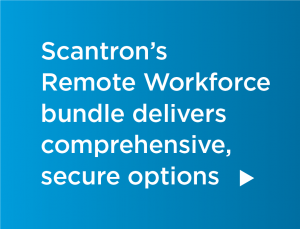As more organizations expand or adjust remote workforce plans, Scantron Technology Solutions has some advice about what to remember when defining and enhancing IT support:
 Consider investing in portable devices such as laptops, tablets, etc., instead of desktop computers. Whether ultimate plans include all remote employees, all on-premise employees, or a blend of options, providing portable devices expands the flexibility for staff working locations.
Consider investing in portable devices such as laptops, tablets, etc., instead of desktop computers. Whether ultimate plans include all remote employees, all on-premise employees, or a blend of options, providing portable devices expands the flexibility for staff working locations.- When deployment of portable devices expands, so does the need for portable device support, such as hardware support, imaging, local data back-up. Don’t forget to include plans for how to support devices in your remote workforce strategy.
- Work-from-home must be viable on a mass scale. Can the company VPN handle the traffic? Is there a need to enhance VPN speed, concurrent-login capacity? What works well when only a few employees connect to the VPN may not work at all when all of them do.
- How do you want to support phone calls? Can the current company phone system support distributed VoIP capabilities, such as soft phones for each employee’s home office? If not, can the phone system be set to forward to their cell? Can IT staff support the phone system?
- Don’t forget about the cloud. Cloud-based infrastructure, applications, and storage can mitigate some on-premise concerns. Consider hosting some or all servers with a service provider, rather than on-premise. Using virtual desktops can also make a big difference to remote staff.
- Keep cybersecurity front-of-mind. Security must be ubiquitous regardless of whether employees are working from your location or their homes. Don’t assume home offices have sufficient tools for cybersecurity. Consider security solutions such as managed firewalls, endpoint protection, OpenDNS, etc., that address security concerns regardless of physical location.
- Make sure you plan for redundancy in your supply chain. Now is a great time to review critical supply chain and service sources to ensure they can support a remote workforce.
- The paperless office might finally be coming into its own. In a distributed workplace, it’s better to have e-workflow versus a paper one. This can also be a great time to review your internal operations processes and improve them. Most of the improvements you make will likely be effective and useful whether your remote workforce plan is permanent or temporary.

Social
View our latest posts or connect with us below on Social Media.